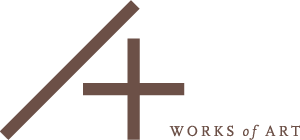
Agus Suwage Indonesia, b. 1959
Borneo - The Missionaries and The Hornbill, 2021
Watercolour, ink, tobacco juice, acrylic on old note student book
113 x 137 cm
Agus Suwage’s ‘Borneo -The Missionaries and The Hornbill’ demonstrates how watercolours, when applied with a dry brush or layered intensively on the surface, can be built upon to produce a...
Agus Suwage’s ‘Borneo -The Missionaries and The Hornbill’ demonstrates how watercolours, when applied with a dry brush or layered intensively on the surface, can be built upon to produce a finish that is both thick and resilient. This method of application opens us up to histories and narratives that reject dilution.
We see this in the built-up fluorescent yellows of Suwage’s painting, where the artist re-examines the history of the large-scale Christianisation of Borneo’s indigenous communities. Christianity first entered Borneo in 1847 with the arrival of Rajah JamesBrooke, who gradually established an Anglican mission loaded with “civilising” aims to morally and materially uplift the Dayak communities. In Suwage’s telling of the story, six indigenous youths are painted behind a yellow hand on the left, a nod to Michelangelo’sGod in The Creation of Adam with its index finger pointed in judgement. To the right, a half-hornbill, half-human figure, representing the symbol of the highest goddess for theDayak peoples, turns towards the hand whilst gesturing in the opposite direction.Suwage’s message is clear: this is a time for countering ongoing processes of erasure and dispossession. With a surface composed of forty sheets of annotated sheets from a student’s notebook tied together with thread, Suwage transforms this palimpsest of thoughts and memories into a claiming space for autonomy and self-determinacy.
We see this in the built-up fluorescent yellows of Suwage’s painting, where the artist re-examines the history of the large-scale Christianisation of Borneo’s indigenous communities. Christianity first entered Borneo in 1847 with the arrival of Rajah JamesBrooke, who gradually established an Anglican mission loaded with “civilising” aims to morally and materially uplift the Dayak communities. In Suwage’s telling of the story, six indigenous youths are painted behind a yellow hand on the left, a nod to Michelangelo’sGod in The Creation of Adam with its index finger pointed in judgement. To the right, a half-hornbill, half-human figure, representing the symbol of the highest goddess for theDayak peoples, turns towards the hand whilst gesturing in the opposite direction.Suwage’s message is clear: this is a time for countering ongoing processes of erasure and dispossession. With a surface composed of forty sheets of annotated sheets from a student’s notebook tied together with thread, Suwage transforms this palimpsest of thoughts and memories into a claiming space for autonomy and self-determinacy.
Exhibitions
This Time: Contemporary Watercolours, A+ WORKS of ART, Kuala Lumpur, 30 October –27 November 20211
of
7
